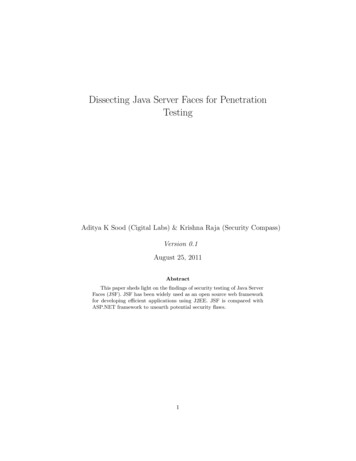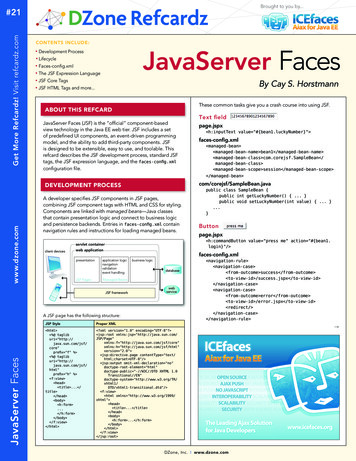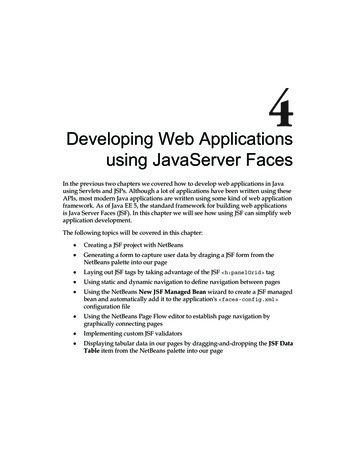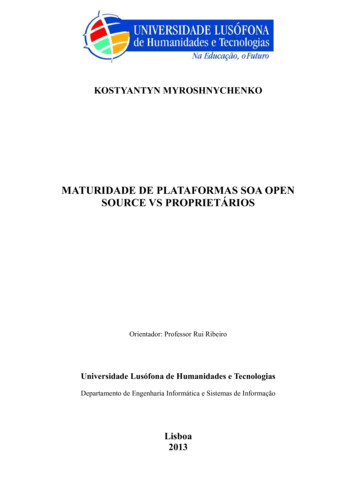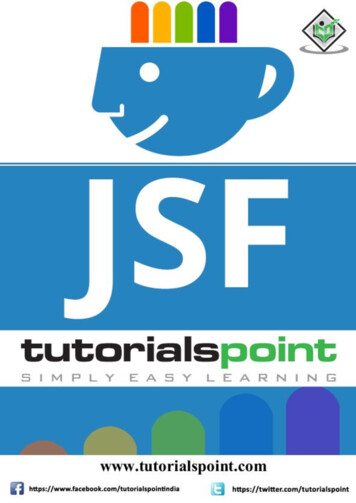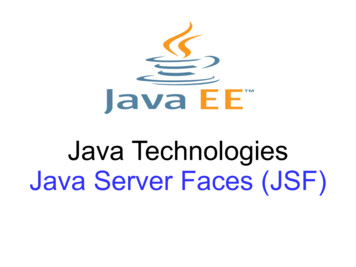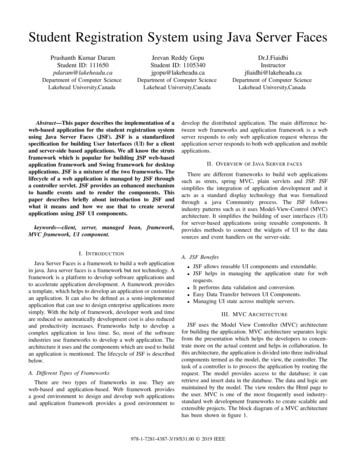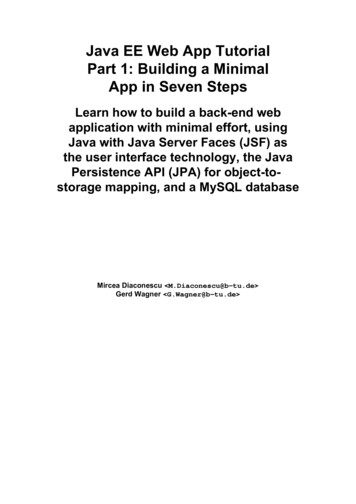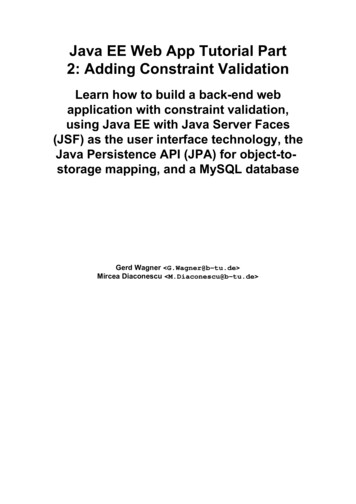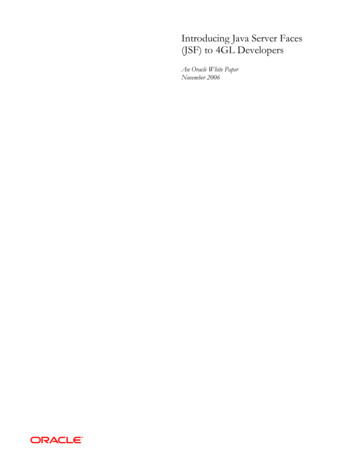
Transcription
Introducing Java Server Faces(JSF) to 4GL DevelopersAn Oracle White PaperNovember 2006
Introducing Java Server Faces (JSF) to 4GLDevelopersIntroduction . 4Introducing JSF . 4A Brief History Lesson . 4Before JSF . 5JSF In the Community . 5Oracle’s contribution . 6Contribution from others. 6Understanding JSF . 6Introducing the component . 6The component architecture . 7Supporting the component. 8A simple component example. 8The event model . 10Action events . 10Value change events. 10Phase events. 11The page flow. 12Introducing faces-config.xml. 12The action attribute. 13The managed bean. 13Managed bean definition. 14Referencing the managed bean . 15Converters and validators. 15Converters . 16Validators. 16The JSF lifecycle . 16Overview. 16Looking at the phases. 17Restore View. 17Apply Request Values. 17Process Validations . 17JSF Advance Features. 18Skinning. 18Render Kits. 19Introducing Java Server Faces (JSF) to 4GL DevelopersPage 2
Ajax . 19Conclusion. 20Introducing Java Server Faces (JSF) to 4GL DevelopersPage 3
Introducing Java Server Faces (JSF) to 4GLDevelopersINTRODUCTIONIBM, BEA, Sun and others have alsocommitted to using JSF as their UItechnology.The past couple of years have seen the emergence of JSF (Java Server Faces) as thetechnology of choice for building the user interface (UI) layer of Java webapplications. Oracle’s own business applications are committing to JSF as the UItechnology in the “Fusion” stack.The component based architecture gives business developers simple, yet powerful,UI components with which to build applications; while being based on standardsmeans that the larger development community can collaborate to build richer andmore advanced components.This paper will introduce JSF to 4GL developers, showing how the componentscan be used, and behind the scenes, how the components work.INTRODUCING JSFThe Java Community Process (JCP), which is responsible for defining the standardfor JSF – initially released as JSR-127 (Java Specification Request 127)- states oneof its goals is to: “ establish a standard API for creating Java Web application GUIs,which will eliminate the burden of creating and maintaining GUI infrastructure for developers.”Which means that JSF is about components in the traditional UI sense of widgetslike buttons, text fields and check boxes. It is not slaved to the traditional mark-upcentric view of previous web technologies: a button is a button, not a tag. It hasbehavior, you can listen for it being pressed and the infrastructure to support whathappens when it is pressed is taken care for you. Which is exactly what you havebeen used to in the Oracle Forms, Visual Basic and PeopleTools world.A Brief History LessonFrom its formative years in 2001, the first release in 2003, up to the current release(JSF 1.2 JSR-252) in 2006 the JCP has brought together resources from thecommunity, including Oracle, to define the specification and produce a referenceimplementation of the specification.Introducing Java Server Faces (JSF) to 4GL DevelopersPage 4
Before JSFIt is difficult to see how far JSF has raised the bar for Java web application UIswithout first being aware of the development experience (or lack of) that was thecatalyst for the simpler UI component based view that JSF typifies.Static HTMLIn the formative years of the web, static HTML (Hyper Text Markup Language)pages made up the bulk of any content you would see on the web. The overridinglimitation was that as static pages it became difficult to display any sort of dynamicdata like a list of products held in a database. Furthermore, if you wanted to domore than simply serve up a series of static pages, you also had to code your owncommunication to and from the server using the HTTP Post and Get messages asthe carrier.ServletsStrictly speaking servlets do not have togenerate HTML; they can generate anymarkup language dependant on the enduser device: e.g. a mobile phone or PDA.To overcome the limitations of static pages, servlets were introduced. Simply aJava program that would do some processing and output a string of HTML tags asits result. Thus, the development of a web page required the developer to code aprogram that would output the tags to be rendered by the browser. Again,developers would also still have to manage the Post and Get communicationhighlighted above.Java Server PagesIn order to move away from this programmatic view of web page development,the next step in the evolution brought us to Java Server Pages (JSP). These were“special” tags that could be embedded into a web page. These tags were used bythe JSP container to generate servlets, that in turn generated the markup. So, youhad the concepts of developers who could develop JSP tags, and possibly adifferent set of developers who could use the tags via JSTL (JSP Standard TagLibraries).However, this still represented a “tag” based view of UI development and stillrequired the UI developer to understand the intricacies of HTTP protocols and tomanage state.Thus, JSF finally brings the development of web UIs to the stage where developerscan work with visual controls that support an event model and allow visual editingthrough IDEs such as Oracle JDeveloper.JSF In the CommunitySo, being a ratified standard, anyone can develop their own set of JSF componentsfor use, and anyone could implement their own JSF runtime on which thosecomponents run. And that is what we are seeing in the wider community.Introducing Java Server Faces (JSF) to 4GL DevelopersPage 5
Oracle’s contributionOracle is one of the leading expert groups involved in the JSF specification,contributing their experiences from their own web framework used by the OracleApplications developers: UIX (User Interface XML). As a result of the work onthe specification, the library of UIX components was redeveloped as standard JSFcomponents. This set of components is called ADF Faces and can be used on anyruntime implementation of JSF.Being committed to the open source community, Oracle has also donated theirADF Faces implementation to the Apache community, and within this communitythis offering is called Trinidad.Contribution from othersSun, who are also involved in the JCP, provide a reference implementation for theJSF framework (the environment on which the JSF components run) and that nowappears in the Java Enterprise Edition (EE) 5.MyFaces, from the Apache community, provide both a 1.1 referenceimplementation as well as a component library. Other offerings include Glassfish,which is an open source implementation of Java EE 5 application server andcontains a JSF 1.2 implementation.The bottom line is components are standardized within JSF and you can use anycomponent from any vendor and mix and match them as required.For the remainder of this paper we willstudy and use the ADF Faces set ofcomponents; although the general pointscould apply to any JSF implementation.UNDERSTANDING JSFSo, now with an understanding of the need for a component based solution, thenext step is to look at these components and what features they offer.Introducing the componentFigure 1 shows a small sample of some of the ADF Faces components. Each webpage in your application will be constructed from components. Components willtypically be nested inside other components (called layout components orcontainers) to provide the required layout.Introducing Java Server Faces (JSF) to 4GL DevelopersPage 6
Figure 1 – ADF Faces componentsThe component architectureEach component is typified by three parts: attributes, behavior and renderers.AttributesEach component has a number of attributes associated with the component. Forexample, a button will have an attribute text that defines the text label that appearson the button; or a background-color attribute to define the background color.BehaviorThe component defines a number of actions that control the behavior of thatcomponent. For example, a button provides a valueChange event on which adeveloper associates code.RenderersThe component itself has attributes and behavior as indicated above but that saysnothing about how the component will actually look. That is the responsibility ofthe renderer. It is the job of the renderer to realize the component as defined as aconcrete screen instruction – e.g. in the case of a browser application – a fragmentof HTML mark-up.JSF UI components are not limited togenerating markup. For example UIComponents can also render binary datasuch as an image streams or differentHaving separate (or pluggable) rendering is one of the most compelling features ofJSF. The fact that the component behavior is de-coupled from the way it isdisplayed means that the same UI component can be displayed differently – forexample, depending on the device to which it is rendered.document types such as SVG, PDF andWord.Introducing Java Server Faces (JSF) to 4GL DevelopersPage 7
Supporting the componentHowever, the component does not live in isolation. The JSF runtime provides anumber of features to support the components.Managed beansThe managed bean is simply a Java object that provides integration between the UIcomponent and the data object the component is displaying. You can define thescope of these objects by indicating that they exist for the lifetime of theapplication, when only requesting a web page, or a session covering a number ofweb pages.Expression LanguageExpression Language (EL) is a scripting language that is part of the JSF runtimeand provides simplified expressions for accessing the data, managed beans and thevarious properties of the components. EL is a very powerful feature of JSF. Forexample, a component attribute (such as required) can be set by an EL expressiondepending on the value of data in a backing bean:#{emp.MaritalStatus ’single’}So if the value of MaritalStatus is “single” (and so the expression evaluates as true)then the required attribute will be set to true.Oracle ADF uses EL as the language to bind the UI components to the underlyingdata.Navigation caseThe JSF framework allows developers to define a set of rules that define thenavigation between pages. By default, this is defined in a file called faces-config.xmland is covered later in this paper.LifecycleThe JSF Request Processing Lifecycle (more commonly referred to as JSF lifecycle)is, as the name suggests, the various stages of processing in the life of a specific JSFrequest. At certain points in the JSF lifecycle specific actions will happen; whetherit is the component retrieving its current state, or rendering the component.A simple component exampleSo, in order to understand how each of these “parts” works as part of the whole,lets look at a simple case of a JSF text field component on a web page.Introducing Java Server Faces (JSF) to 4GL DevelopersPage 8
For simplicity, some tags have beenomitted.Figure 2 – Simple exampleIf you change from the design view of the page to the code view in the JDevelopervisual editor, you can see the source JDeveloper has created for you. There aretwo tags in the source code: f:view h:inputText The first is the top-level container in which all the UI components will appear. JSFholds the definition of the page in a component tree (which can be manipulated atruntime) and f:view encapsulates this components tree. h:inputText is a UI component in this tree and represents the input text field.Today the implementations of JSF happensHiding the implementation detailsto use JSP as a carrier technology. That is,Note that the input field has a property required which is set to true, and a propertyvalue, which is being resolved by an EL expression via a managed bean. However,there is absolutely no detail of how the component implements the properties or infact, how the component actually renders itself.the page definitions are JSP pages and theJSF components are expressed as JSP taglibraries. This however is a convenience, itmeans that conventional HTML / JSPeditors and IDEs can be used to design JSFpages. JSF itself makes no assumptionsabout the format of the page definition.So this component could render itself using HTML markup up if displaying in abrowser, WML (Wireless Markup Language) if displaying on a mobile device, orpossibly even some hybrid of markup and JavaScript (refer to Ajax, covered later).And that is the beauty of JSF to the business developer, the implementation detailof the UI control is hidden. The component simply exposes functionality andfeatures (as a UI component would in Visual Basic or Oracle Forms).Introducing Java Server Faces (JSF) to 4GL DevelopersPage 9
The event modelThe next step is to consider how the UI component initiates and reacts to UIactions or events such as pressing a button or selecting a value from a list.JSF provides an event model that supports three types of events.Action eventsAn action event in analogous to a WhenButton-Pressed trigger in Oracle Forms.An action event occurs when a JSF UI component, like a button or link, is clicked.Figure 3 shows a simple JSF page consisting of an input field, a button and anoutput field, which will display the data from the input field concatenate with thestring “hello”.Figure 3 – Simple event exampleBy double-clicking on the button,JDeveloper will automatically create aplaceholder for your code. JDeveloper willJDeveloper allows you to add a method to the Action attribute, which will executethe following code (held in a managed bean)public String buttonPressed action() {also create a backing bean for you and// Add event code here.accessor methods for getting and settingthe value of the UI components.String inputText ).setValue(inputText " hello!");;Note that this method returns a String, inreturn null;this case null. The importance of thisstring is discussed later in the navigation}sectionValue change eventsInput UI components such as input text fields have two events that are triggeredwhen changing data. A ValueChangeListener fires when a value in the field haschanged and Validator fires to validate the data entry. Again, JDeveloper providesIntroducing Java Server Faces (JSF) to 4GL DevelopersPage 10
a simple dialog to define the name of the method, the managed bean in which themethod is placed and will generate the correct method signature (Figure 4)Figure 4 – Creating a valueChangeListenerPhase eventsPhase events execute at specific instances in the JSF lifecycle, allowing you to addyour own code into the JSF lifecycle at points such as validation phase, or updatingthe model with values phase.The significant point for any of these events is not what you can code, but insteadwhat you DON’T have to code. There is no need to process the HTTP request to check what event israised. There is no need to process the HTTP request to find out what value wastyped into the input text field There is no processing the HTTP response to set the value of the outputfield. This is done be setting an attribute on the output text field.Introducing Java Server Faces (JSF) to 4GL DevelopersPage 11
The JSF framework provides a layer of abstraction to deal with the “plumbing” ofassociating an action with a piece of code and allowing to code to access attributesof the components.The page flowAs well as defining a framework for components on a page, JSF also defines aframework for managing the flow between application pages. So, performing aparticular action on a page results in navigation to another web page.Introducing faces-config.xmlNote that the faces-config.xml file containsmore information than just the navigationrules. As an introduction to JSF, yourprimary involvement with this file will bedefining navigation but it also used tospecify managed beans, render kits,converters and validators.As you would expect, JSF handles the flow of your application through the webpages with minimum of coding on the developer’s part. Instead, an XML filedefines what action on a specific page results in navigation to another specificpage. This XML file is called faces-config.xml.Figure 5 shows an example faces-config.xml file with a navigation case on thebrowserCustomers page. An edit action would result in navigation to the editCustomerspage, while a showOrders action would result in navigation to the customerOrders webpage.Figure 5 – Faces-config.xmlIntroducing Java Server Faces (JSF) to 4GL DevelopersPage 12
However, JDeveloper makes management of this file even easier by providing avisual editor for defining and visualizing the page navigation rules.Figure 6 – Faces-config.xmlThe action attributeIn order to define which UI component actually raises the action you simply setthe action property on the component. This is the same property that wasdiscussed earlier for defining the method to be executed on pressing a button. Theaction property can take the name of a navigation case on the diagram or the nameof a method – which is why the action method discussed earlier, returns a String,which defines the name of the JSF navigation flow to be followed.The managed beanThe role of the managed bean is actually quite simple. It is a place to put coderelating to UI actions (like a button being pressed) and to hold state informationabout the UI (for example, the name of the logged on user). More specifically, amanaged bean contains code generally shared between many pages.Introducing Java Server Faces (JSF) to 4GL DevelopersPage 13
The term Inversion of Control (IoC) is oftenused in describing managed beans. Thissimply means that the management of theobject (in this case the managed bean) ishanded over to the framework instead ofbeing left to the application developer.The lifecycle of a managed bean is handled by JSF – when the bean is firstreferenced, JSF will create an instance of the relevant Java class and keep it aroundas long as is specified by the bean definition.You also have the concept of a backing bean. A backing bean is a specializedmanaged bean created and managed by JDeveloper and is tied to one specific JSFpage. Typically this bean provides accessor methods for each UI component onthe page it backs.You don’t need a backing bean for every page. A page can happily live withoutany backing bean at all, or a backing bean can only contain references to a few ofthe components on the page. In most cases the backing bean will only containaction code and no references to the UI Components – unless you need toprogrammatically manipulate them.In the example above (figure 3) a backing bean was used to reference thecomponents created on the page and to provide a place to put action code.Managed bean definitionManaged beans are registered in the faces-config.xml file; however, JDeveloper canaid you in the creation and referencing of these beans. When a JSF applicationstarts up it reads the faces-config.xml file to make the beans available. There are anumber of configuration options for managed beans.Managed bean propertiesAs well as the place to put UI action code, you can also add variables (like packagevariables in PL/SQL) to the managed bean. Consider the case where you wouldlike to define a value that would be used as the default value for, one or many, UIfields. You can achieve this by using a managed property, which allows you definea property, its type and its value. This could then be accessed using EL topopulate the value of a field. So the entry the faces-config.xml file would include: managed-property property-name defValue /property-name property-class java.lang.String /property-class value hello /value /managed-property And that property could be access from a JSF page by:#{backing page1.defValue}Managed Bean ScopeEach managed bean has a “lifespan”. JSF will instantiate the bean automaticallyand that bean will be available for the defined scope. The scope of the managedbean is set in the faces-config.xml file. There are four possibilities:Introducing Java Server Faces (JSF) to 4GL DevelopersPage 14
Application – the bean is available for the duration of the web application.This is useful for any application global data. Session – the bean is available for the duration of the client’s session. Forexample, a shopping cart application would keep the session informationacross many web pages. Request – the bean is available from the time it is instantiated until aresponse is sent back to the client. For example, from the point a button ispressed to when the response is received back at the client. None – the bean is instantiated each time it is referenced.Referencing the managed beanNow that you have defined information and functionality within your managedbean, you want to be able to access that information.Referencing from ELUsing EL you can reference managed properties from your managed bean. af:inputText id "fieldA" value "#{backing page1.defValue}"/ Thus, on realizing this field, the value of the field would be set to the defValuemanaged property in the backing page1 managed bean.Referencing from JavaYou can also access managed properties from Java as well. To do this you get thecurrent instance of the FacesContext. This object contains all of the stateinformation for the components within the JSF lifecycle. By getting a handle tothe current instance of the FacesContext you can access the elements of the JSFlifecycle.FacesContext fc FacesContext.getCurrentInstance();ValueBinding expr fc.getApplication().createValueBinding("#{backing (fc).toString());Converters and validatorsWhen the user enters data into a JSF page and that page is submitted from thebrowser, all the data on the page is enclosed in the resulting HTTP message asstrings. So, regardless if data entered was a date or a number when the data gets tothe application server for processing it appears as a string.The predicament here is that the developer building the “back-end” code willtypically be using Java types (like Integer or Date) to manipulate that data.Introducing Java Server Faces (JSF) to 4GL DevelopersPage 15
Without the use of a framework this would require writing code to convert thestrings to the correct data type.However, this functionality is provided to you through JSF.ConvertersAs the name would suggest, a converter is responsible for converting String data toa type such as java.util.Date or java.lang.Number. JDeveloper provides a palette ofconverters and will also automatically add converters for components that wouldreasonably require them: e.g. an input field that is bound to date data. Thus, dataentered that represents a date, and is transmitted via HTTP as a string, can still betyped in the back end code as a java.util.Date.ValidatorsValidation, on the other hand, is the process whereby editable component data isvalidated against rules or conditions before the data is updated into the modellayer. Thus, before posting data on the page, validation will check the data is, forexample, within defined limits ( af:validateDateTimeRange ). As with converters,JDeveloper provides a palette of validators and will automatically include them oncertain UI items.THE JSF LIFECYCLEWe have already come across the phrase “JSF lifecycle” in this paper and it isworth looking at what this means in a little more detail.OverviewOnce a request starts being processed (e.g. as the result of pressing a button), JSFgoes through a set series of steps. These steps are called the lifecycle. The lifecycleof a JSF page is similar to the lifecycle of most web pages: the client makes anHTTP request, the application server receives and processes the request andresponds in HTML. The JSF lifecycle, however, manages a UI component tree onthe server and also controls events and handles state changes.While outside the scope if this paper, theJSF lifecycle can be customized if yourequire specialized behavior.The JSF lifecycle uses the component tree to handle application requests andcreate rendered responses. Depending on the type of request and response, JSFexecutes different tasks in different phases of the request processing lifecycle, andthen creates a view of the page (component tree) for rendering (in the RenderResponse phase).Introducing Java Server Faces (JSF) to 4GL DevelopersPage 16
Figure 7 – JSF lifecycleLooking at the phasesThe fine details of each of the phases are beyond the scope of this paper, however,an acknowledgement of their existence and general function is useful. In brief, theJSF lifecycle phases are as follows:Restore ViewAn internal view of the page is held in a component tree. In this phase, thecomponent tree of a page is newly built or restored. All the component tags, eventhandlers, converters, and validators have access to the FacesContext instance. If it isa new empty tree, the lifecycle proceeds directly to the Render Response phase.Apply Request ValuesEach component in the tree extracts its new value from the request message andstores it locally. If a component has its immediate attribute set to true, then thevalidation, conversion, and events associated with the component is processedduring this phase.Process ValidationsThe local values of the components are converted and validated. If there areerrors, the lifecycle jumps to the Render Response phase. At the end of this phase,new component values are set, and any conversion error messages and events arequeued on FacesContext.Update Model ValuesThe component objects' properties are set to the validated local values.Invoke ApplicationApplication level code is executed such as action events.Render ResponseIntroducing Java Server Faces (JSF) to 4GL DevelopersPage 17
The components in the tree are rendered as the web container traverses the tags inthe page. State information is saved for subsequent requests and the Restore Viewphase.JSF ADVANCED FEATURESAs an introductory paper, these advanced features are beyond the scope of thispaper. However, an acknowledgement of their basics is useful to know.SkinningSkinning is the ability to define an overall “look and feel” to an application UI. Inthe same way that Windows allows you to define a theme for your desktop, ADFFaces provides this feature by using JSF’s pluggable rendering technology.Figure 8 – SkinningFigure 8 shows the same application rendered using different skins. ADF Facescomes with a number of pre-configured skins but you can develop your owncustom skins through manipulation of CSS (Cascading Style Sheet) tags.Introducing Java Server Faces (JSF) to 4GL DevelopersPage 18
Render KitsEach JSF component is responsible for outputting its own markup tags that areused by the end device to physically render the screen. ADF Faces providesrender kits for HTML, mobile and telnet.Figure 9 – Render kitsFigure 9 shows samples of an application rendered using different render kits. JSFalso has the provision of allowing you to develop your own render kits.AjaxWeb UIs work on a “click an
Introducing Java Server Faces (JSF) to 4GL Developers Page 5 Before JSF It is difficult to see how far JSF has raised the bar for Java web application UIs without first being aware of the development experience (or lack of) that was the catalyst for the simpler UI component based view that JSF typifies. .
